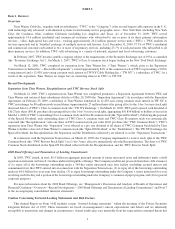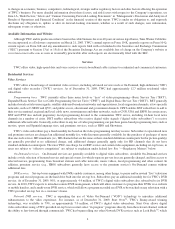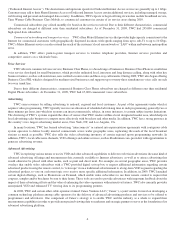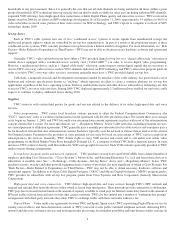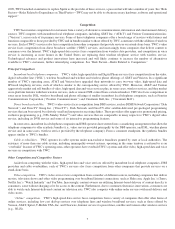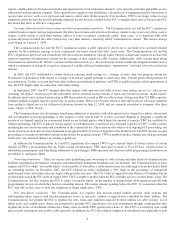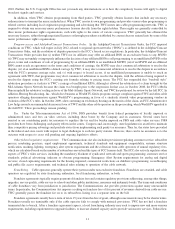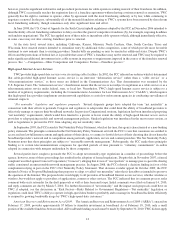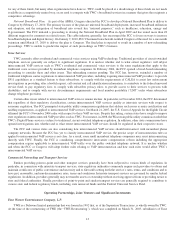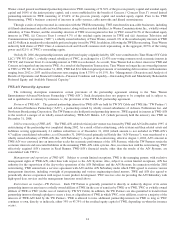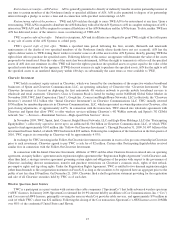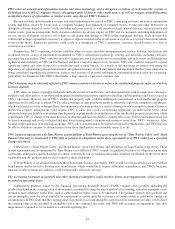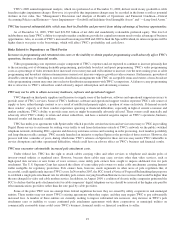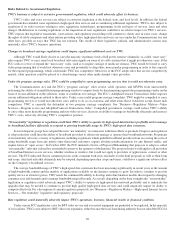Time Warner Cable 2009 Annual Report Download - page 22
Download and view the complete annual report
Please find page 22 of the 2009 Time Warner Cable annual report below. You can navigate through the pages in the report by either clicking on the pages listed below, or by using the keyword search tool below to find specific information within the annual report.attachments made by any company that provides telecommunications services. The applicability of and method for calculating pole
attachment rates for cable operators that provide Voice Over Internet Protocol (“VoIP”) services remains unclear. In November 2007, the
FCC issued a Notice of Proposed Rulemaking that proposes to establish a new unified pole attachment rate that would apply to
attachments made by cable operators and telecommunications companies that are used to provide high-speed Internet services. It is
unclear whether this ruling would apply to VoIP services or have any effect on the pole attachment rates for companies providing
telecommunications services. The proposed rate could be higher than the current rate paid by cable service providers. In addition, in
August 2009, a coalition of electric utility companies petitioned the FCC to declare that the pole attachment rate for attachments used by
cable companies to provide VoIP services should be assessed at the higher rate paid by telecommunications providers. TWC has opposed
this petition. If either of these petitions is adopted, TWC’s current payments for pole attachments could materially increase. Finally, some
of the poles TWC uses are exempt from federal regulation because they are owned by utility cooperatives and municipal entities. These
entities may not renew TWC’s existing agreements when they expire, and they may require TWC to pay substantially increased fees. A
number of these entities are currently seeking to impose substantial rate increases. Any increase in TWC’s pole attachment rates or
inability to secure continued pole attachment agreements with these cooperatives or municipal utilities on commercially reasonable
terms could cause TWC’s business, financial results or financial condition to suffer. For further discussion of pole attachment rates, see
the discussion in “Risk Factors—Risks Related to Dependence on Third Parties—TWC may encounter substantially increased pole
attachment costs.”
Set-top box regulation. Certain regulatory requirements are also applicable to set-top boxes and other equipment that can be used
to receive digital video services. Currently, many cable subscribers rent from their cable operator a set-top box that performs both signal-
reception functions and conditional-access security functions. The lease rates cable operators charge for this equipment are subject to rate
regulation to the same extent as basic cable service. Under these regulations, cable operators are allowed to set equipment rates for set-top
boxes, CableCARDs and remote controls on the basis of actual capital costs, plus an annual after-tax rate of return of 11.25%, on the
capital cost (net of depreciation). In 1996, Congress enacted a statute requiring the FCC to pass rules fostering the availability of set-top
boxes. An implementing regulation, which became effective on July 1, 2007, requires cable operators to cease placing into service new
set-top boxes that have integrated security functions. DBS operators are not subject to this requirement.
In December 2002, cable operators and consumer-electronics companies entered into a standard-setting agreement relating to
reception equipment that uses a conditional-access security card—a CableCARD—provided by the cable operator to receive one-way
cable services. To implement the agreement, the FCC adopted regulations that (i) establish a voluntary labeling system for such one-way
devices; (ii) require most cable systems to support these devices; and (iii) adopt various content-encoding rules, including a ban on the
use of “selectable output controls” to direct program content only through authorized outputs. In June 2007, the FCC initiated a Notice of
Proposed Rulemaking that may lead to regulations covering equipment sold at retail that is designed to receive two-way products and
services, which, if adopted, could increase TWC’s cost in supporting such equipment. This Notice of Proposed Rulemaking remains
pending. In June 2008, cable operators and consumer-electronics companies entered into a Memorandum of Understanding that
establishes a national platform for retail devices to receive interactive (or two-way) cable services.
In November 2009, in its National Broadband Plan proceeding, the FCC identified a set-top box “innovation gap” that it stated could
hinder the convergence of video, TV and IP-based technology. In December 2009, the FCC sought specific comment on how it can
encourage innovation in the market for navigation devices. If the FCC requires multi-channel video programming distributors
(“MVPDs”) and consumer electronics manufacturers to develop a universal “plug-and-play” device for all MVPDs, it may impede
innovation in this area.
Multiple dwelling units and inside wiring. In November 2007, the FCC adopted an order declaring null and void all exclusive
access arrangements between cable operators and multiple dwelling units and other centrally managed real estate developments
(“MDUs”). In connection with the order, the FCC also issued a Further Notice of Proposed Rulemaking regarding whether to expand the
ban on exclusivity to other types of MVPDs in addition to cable operators, including DBS providers, and whether to expand the scope of
the rules to prohibit exclusive marketing and bulk billing agreements. The U.S. Court of Appeals for the District of Columbia Circuit
upheld the order in May 2009. The FCC also has adopted rules facilitating competitors’ access to the cable wiring inside such MDUs.
This order, which was upheld by the U.S. Court of Appeals for the District of Columbia Circuit in October 2008, could have an adverse
impact on TWC’s business because it allows competitors to use wiring inside MDUs that TWC has already deployed.
Copyright regulation. TWC’s cable systems provide subscribers with, among other things, content from local and distant
television broadcast stations. TWC generally does not obtain a license to use the copyrighted performances contained in these stations’
programming directly from program owners. Instead, in exchange for filing reports with the U.S. Copyright Office and contributing a
percentage of revenue to a federal copyright royalty pool, cable operators obtain rights to retransmit copyrighted material contained in
broadcast signals pursuant to a compulsory license. The elimination or substantial modification of this compulsory copyright license has
been the subject of ongoing legislative and administrative review, and, if eliminated or modified, could adversely affect TWC’s ability to
obtain suitable programming and could substantially increase TWC’s programming costs. Additionally, the U.S. Copyright Office has
released a ruling on issues relating to the calculation of compulsory license fees that could increase the amount cable operators are
required to pay into the copyright royalty pool. Legislation has been introduced to address this issue and it is pending as of February 18,
10



